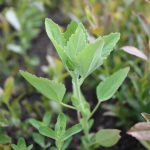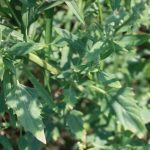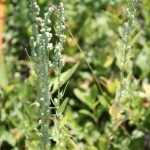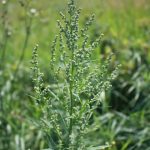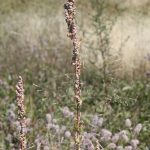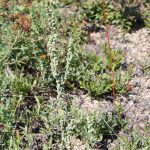Lambsquarters
Prepared by Jennifer L. D’Appollonio, Assistant Scientist, University of Maine, Orono, ME 04469. Updated February 2018.
Scientific name: Chenopodium album L.
Common name(s): lambsquarters, white goosefoot
Links: USDA PLANTS Profile , NPIN Profile, Go Botany
Images: (to see enlargements [PC]: click on image, then right click and choose “view image”)
- young plant, mid-June (taller plant behind seedlings)
- lower leaves toothed/lobed, upper are entire. Note lack of “mealy” hairs on plant surfaces
- early flower, mid-July
- flowering, mid-August. Note 5 keeled sepals (“star-shaped”)
- late August, some sepals open to show black seeds
- late August
Description:
-annual
-species is highly variable in appearance
-needs a microscope to distinguish from other Chenopodium
-Characteristics include
- glandular hairs which give leaves/flowers a mealy appearance,
- 5 keeled sepals
- lower leaves lobed/toothed but upper leaves entire, etc. However, characteristics may vary (see photos with lack of glandular hairs).
- Most consider the differences in plants to be varieties, but some separate into distinct species. See also Flora Novae Angliae information at the bottom of the Go Botany webpage
-the leaves are a food sources to:
- catepillars
- beetles
- mammals
-may be confused with C. berlandieri or C. strictum; see left sidebar on Go Botany webpage
Habitat:
-full sun
-disturbed areas
-fields and weadows
Management:
-pulling up seedlings
-mowing over plants before seed production
Natural History:
-native to Eurasia
-Native Americans used the dried seeds to make flour
-the plants can be edible
- due to saponins, cook, steam, or freeze before eating
Source(s):
Haines, A., Farnsworth, E., Morrison, G., & New England Wild Flower Society. (2011). New England Wildflower Society’s Flora Novae Angliae: A manual for the identification of native and naturalized higher vascular plants of New England. Framingham, MA: New England Wild Flower Society. p. 323.
NC Extension. “Chenopodium Album.” North Carolina Extension Gardener Plant Toolbox, NC State University, 2020, plants.ces.ncsu.edu/plants/chenopodium-album/.

